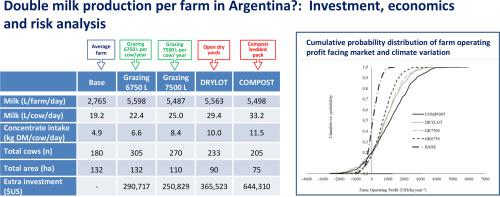Agricultural Systems ( IF 6.1 ) Pub Date : 2022-01-24 , DOI: 10.1016/j.agsy.2022.103366 Javier Baudracco 1, 1 , Belén Lazzarini 2 , Noelia Rossler 2 , Laura Gastaldi 3 , José Jauregui 2 , Santiago Fariña 4

|
Context
Demand for dairy products is expected to continue driving intensification in dairy systems. Little is known about the productive and economic performance and risk of intensification strategies either within grazing systems or confinement dairy systems in Argentina.cu
Objective
This study investigated four strategies to double milk production for the average grazing dairy system of Argentina (BASE), using either grazing or confinement systems. Physical and economic performance and risk associated with each alternative was explored using a modelling approach. Investment of capital required to establish each alternative was estimated.
Methods
Four scenarios that double milk production per farm from a BASE scenario were designed and modelled using a whole-farm model named e-Dairy: two grazing dairy systems with different milk yield per cow per year: GR6750 (6750 L/cow per year) and GR7500 (7500 L/cow per year) and two confinement systems, an open dry yard (DRYLOT) and a compost bedded pack (COMPOST). Stochastic budgeting was used to model the combined influence of variation in milk, price and crops yield. Outputs of the stochastic analysis are shown in the form of cumulative distribution functions (CDF).
Results and conclusions
All the intensification alternatives increased milk production per ha from 7800 L, in BASE system, to 18,209 and 26,758 L in grazing and confinement systems, respectively. Intensified scenarios required an investment of capital between two and three times higher than the BASE scenario. All scenarios had positive economic results. The BASE scenario showed both the lowest farm operating profit and the lowest return on assets ($99/ha per year and 4.1%, respectively). Intensified grazing systems had the highest return on assets (above 12%), while the COMPOST system showed the highest farm operating profit ($1121/ha per year) and the lowest return on assets (7.5%) of the intensification alternatives explored. According to stochastic simulations, the COMPOST and DRYLOT scenarios would expose farmers to a greater maximum loss than BASE and grazing scenarios when negative farm operating profit occurred. However, cumulative distribution functions of profit showed that they would have higher profit than BASE and grazing scenarios along most of the CDF curve.
Significance
Farmers who decide to intensify their systems will have higher profit compared with BASE scenario, but should be prepared to afford higher investment and also to cope with increased variability of profit under price or climate risk. If the switch from a BASE scenario was to be implemented at a national scale, it would impact on surplus milk that might cause significant changes beyond farm gate. Further research is required to investigate the environmental impact of intensification alternatives.
中文翻译:

阿根廷每个农场牛奶产量翻番的策略:投资、经济和风险分析
语境
预计对乳制品的需求将继续推动乳制品系统的集约化。对阿根廷放牧系统或圈养奶牛系统中集约化战略的生产和经济绩效以及风险知之甚少。
客观的
本研究调查了阿根廷平均放牧奶牛系统 (BASE) 使用放牧或圈养系统的四种牛奶产量翻倍策略。使用建模方法探索了与每种替代方案相关的物理和经济绩效和风险。估计了建立每个替代方案所需的资本投资。
方法
使用名为 e-Dairy 的全农场模型设计和建模了四个场景,使每个农场的牛奶产量从 BASE 场景中翻倍:每头奶牛每年产奶量不同的两个放牧奶牛系统:GR6750(6750 L/奶牛每年)和GR7500(每年 7500 升/头牛)和两个封闭系统、一个开放式干燥场 (DRYLOT) 和一个堆肥垫层包装 (COMPOST)。随机预算用于模拟牛奶、价格和作物产量变化的综合影响。随机分析的输出以累积分布函数 (CDF) 的形式显示。
结果和结论
所有集约化替代方案都将每公顷的牛奶产量从 BASE 系统中的 7800 升分别增加到放牧和圈养系统中的 18,209 和 26,758 升。强化情景需要的资本投资比 BASE 情景高出两到三倍。所有情景都有积极的经济结果。BASE 情景显示农场经营利润最低,资产回报率最低(分别为每年 99 美元/公顷和 4.1%)。在所探索的集约化替代方案中,集约化放牧系统的资产回报率最高(超过 12%),而 COMPOST 系统显示出最高的农场运营利润(每年 1121 美元/公顷)和最低的资产回报率(7.5%)。根据随机模拟,当农场经营利润为负时,COMPOST 和 DRYLOT 情景将使农民面临比 BASE 和放牧情景更大的最大损失。然而,利润的累积分布函数表明,在 CDF 曲线的大部分区域,它们将比 BASE 和放牧情景具有更高的利润。
意义
与 BASE 情景相比,决定强化系统的农民将获得更高的利润,但应准备好承担更高的投资,并应对价格或气候风险下利润的增加变化。如果要在全国范围内实施从 BASE 情景的转换,它将影响剩余牛奶,这可能会导致农场门以外的重大变化。需要进一步研究来调查集约化替代方案对环境的影响。











































 京公网安备 11010802027423号
京公网安备 11010802027423号